(Intro taken from: By Quiling Secusana, THE NEWS TODAY)
The Holy Week in the Philippines has various appeals for everyone that combine native traditions and modern day touches with numerous innovations according to temperament and locale.
The week from Monday to Good Friday is an emotion packed series of religious ceremonies reminiscent of Christendom's most cherished traditions. Easter Sunday pall builds up into a glorious pealing of church bells for the pre-dawn "pasalubong", a reenactment of the Risen Christ's meeting with His Mother at the church patio under a specially prepared arch. An angel then descends from the platform and lifts the mourning veil of the grieving Mother amidst the pealing of bells. The procession of the two images then ends up inside the church and masses are said.
Lenten celebration in the Philippines is a conglomeration of quaint Christian and paganistic practices that are found nowhere else in the world. Some are breathtaking and exciting as they are charming and so distinctively Filipino that they are a source of wonderment for any tourist.
(source of this list: Manila Bulletin)
1) The churches of Ilocos. One common denominator that bonds the Ilocos region is its churches - whether it be the opulent centuries-old Catholic churches or the newer and simpler churches founded by the Ilocano renegade Bishop Gregorio Aglipay in the late 1890’s. The churches of Santa Maria and Paoay are two of four Philippine Baroque churches inscribed in the UNESCO World Heritage List.

Construction of the church started in 1704 and was completed in 1894 by the Augustinian friars led by Fr. Antonio Estavillo.
It is probably the best-known “earthquake Baroque” church in the Philippines. Large coral stones were used for the lower level while bricks were used for the upper levels of the church. The walls are 1.67 meters thick and are supported by 24 carved and massive buttresses.

The Church is a unique combination of Gothic, Baroque and Oriental designs.
The bell tower near the church, dating from 1793, served as an observation point of the “Katipuneros” during the Philippine Revolution in 1896 and again by the guerrillas during the Japanese occupation.
Where: a few km to the south-west of Laoag.
My rating: 10/10: very impressive church.
Info from: My Sarisari Store
2) San Pedro Apostol Church in Loboc, Bohol. The present church was first erected by the Jesuit missionaries in the 18th century, with its walls made of coral stones. The church complex is located near the Loboc river and is composed of the church structure, a three-storey convent, a bell tower situated about 50 meters away from the front and a mortuary chapel.

The Church of San Pedro Apostol de Loboc dates back to 1734, although records refer to an older structure which may have been incorporated into the church’s convent. The present church was first erected by the Jesuit Missionaries and was then later taken over by the Augustinian Recollects. The church complex is composed of the church structure, a three storey convent, a bell tower and a mortuary chapel. The Jesuits and the Augustinians shared in the construction of the church.
The Jesuits designed the church with an intricately- designed facade and a cherub under the opening of every window. The Augustinian Recollects added a portico facade, buttresses, the bell tower and the mortuary chapel. The interior of the church has 18th and 19th century retablos, ceiling that is painted by artisans in the 1920’s and a 19th century pipe organ which was restored in 2001. The roof of the church is made of clay tiles and the walls are of coral stones. At the rear of the church is the convent with three floors and L-shaped with the third floor connected to the church.
The interior of the church is a blast from the past with its mix of Jesuit and Recollect influences. A wooden pulpit that is located on the church’s right lateral wall still hangs though only its tornavoz remains intact. The church also boasts of a pipe organ that can be attributed to Fray Diego Cera, OAR who is the builder of the famous Las Piñas Bamboo Organ. Various biblical scenes are painted on the church’s ceiling which is a testament to the high level of craftsmanship of the local artisans in 1926 and 1927.
The church’s belfry is at the right side of the church structure, straddling the Loboc River. Built in 1768, the four-level octagonal bell tower acts not only as a reminder of the people’s religious obligations but also as a landmark for anyone sailing to town because during the colonial times, Loboc River was navigable, allowing streamers to harbor and giving the town its significant importance. Seven bells hang from the fourth level. Five, including the central and largest one, are still held up by the original vines. The oldest is dated 1863; two, dated 1914 and 1937 (the largest) bear the name of Padre Cayetano Bastes, the Filipino priest who was made to offer his ‘hospitality’ to the American soldiers in 1901. There is also a large wooden matraca cranked during Holy Week when the bells are silent - dated 1899. A clock from the Altonaga Company in Manila, acquired by public subscription, was installed here in 1893.
3) Basilica of the Our Lady of Piat in Cagayan. Piat is now dubbed as the "Pilgrimage Center of Cagayan Valley" because of the thousands of devotees and tourists who come here to pay homage to the image of Our Lady of Piat. People flock everyday to the shrine queueing to touch the image’s feet seeking her intercessions.
4) Baclaran and Quiapo Churches in Manila. Baclaran Church and Quiapo Church are just two of the city’s most popular churches. Baclaran Church is known as the National Shrine of Our Mother of Perpetual Help while the Quiapo Church is known for the Black Nazarene, a life-size image of Christ believed to be miraculous.

The National Shrine of Our Mother of Perpetual Help (also called the Redemptorist church, popularly known as the Baclaran church) is one of the largest churches in the Philippines. It houses an icon, Our Mother of Perpetual Help, which is among the most venerated Marian images in the country.
The shrine is a Roman Catholic parish church. It is under the vicariate of the parish of Santa Rita de Cascia in the Diocese of Parañaque. The edifice is on Roxas Boulevard in the barangay of Baclaran in Parañaque City, Metro Manila. The present rector of the shrine is Rev. Fr. Joseph D. Echano, CSsR.
One of the most widely known churches in Metro Manila, the shrine draws worshippers from many parts of the region and the nation. It is home to the replica of the miraculous icon of Our Mother of Perpetual Help, an object of popular devotion and pilgrimage among all walks of Filipino life, including politicians and celebrities. Devotees flock to the sanctuary every Wednesday in what has become known as Baclaran Day, when a novena is offered to the Mother of Perpetual Help.
Wednesday has been known as Baclaran day since the first Baclaran Novena was conducted on June 23, 1948, a Wednesday. Contrary to popular belief, the Perpetual Novena did not start in Baclaran but in the province of Iloilo at the Redemptorist Church of San Clemente. After witnessing the devotion of the Ilonggos (Iloilo natives) to the Mother of Perpetual Help Novena, the Irish Redemptorist Father Gerard O’Donnell introduced the novena to Baclaran. Father Leo English conducted the first Baclaran Novena with 70 participants.
The icon and the church have undergone changes over time. In 1932, the Redemptorist priests replaced the Mother of Perpetual Help icon with a larger version to accommodate the growing number of devotees. The present church building of Modern Romanesque style is the third to be built on the same site. In December 1952, the National Shrine of Our Mother of Perpetual Help was completed.
The building seats 2,000, but as many as 11,000 people can be inside during masses. An estimated 120,000 devotees are affiliated with the church.
The parish celebrates its fiesta on June 27, the feast day of Our Mother of Perpetual Help.
 Quiapo Church, officially known as Minor Basilica of the Black Nazarene, is a Roman Catholic church located in the District of Quiapo, Manila, in the Philippines. The church is one of the most popular churches in the country. It is home to the Black Nazarene, a much venerated statue of Jesus Christ which many people believe has miraculous attributes. The church was painted cream after the original Mexican Baroque edifice was burned down in 1928. Also known as St. John the Baptist Parish, the church at present belongs to the Archdiocese of Manila. The current rector is Rev. Msgr. Jose Clemente Ignacio, who succeeded Msgr. Josefino Ramirez (the Vicar General of the archdiocese) upon the latter's appointment as rector of the Archdiocesan Shrine of the Divine Mercy in Maysilo, Mandaluyong City.
Quiapo Church, officially known as Minor Basilica of the Black Nazarene, is a Roman Catholic church located in the District of Quiapo, Manila, in the Philippines. The church is one of the most popular churches in the country. It is home to the Black Nazarene, a much venerated statue of Jesus Christ which many people believe has miraculous attributes. The church was painted cream after the original Mexican Baroque edifice was burned down in 1928. Also known as St. John the Baptist Parish, the church at present belongs to the Archdiocese of Manila. The current rector is Rev. Msgr. Jose Clemente Ignacio, who succeeded Msgr. Josefino Ramirez (the Vicar General of the archdiocese) upon the latter's appointment as rector of the Archdiocesan Shrine of the Divine Mercy in Maysilo, Mandaluyong City.5) Agoo Basilica in La Union. Built in 1892, Agoo Basilica or the Shrine of Our Lady of Charity is considered the most beautiful church in La Union. This imposing structure of Mexican-Baroque architecture is the venue of religious rites, foremost of which is the Semana Santa. Also, the much publicized divine visitations of the Virgin Mary in the early 1990’s have established Agoo as a destination of Marian devotees.

The Basilica of Our Lady of Charity or the Agoo Cathedral is located in the heart of the town of Agoo and looms like a big mother to this progressive La Union town. The church was founded in 1578 by two eager and enthusiastic Franciscan priests, Fray John Baptist Lucarelli of Pesaro, Italy and Fray Sebastian de San Francisco of Baesa, Spain when they were assigned in our country for their evangelical mission.
The original church was made of nipa and bamboo and was constructed in Nagreban and dedicated in honor of the founder of the Franciscan Order, St. Francis of Assisi. The church was renovated and enlarged in 1598 under the supervision of Fr. Saturnino Franco with the help of Frs. Casimiro Melgosa and Aquilino Garcia who paved the way to the construction of the three-tiered belfry. However, a disastrous earthquake hit the place in 1892. In the church’s ruins later stood a shrine for Nuestra Señora de Caridad (Our Lady of Charity) which was later demolished in 1975. The present church was finished in 1978 in time for the feast of the Immaculate Conception. It was elevated to rank of Basilica Minore by Pope John Paul II on July 15, 1982.
The rosette stained glass window on the church’s facade provides a colorful contrast to the gray color of the front wall. The statues of Saints Peter and Paul flanked the main door which has Hebrew scripts carved on it. The first thing that will catch one’s attention once inside the church is the altar. It is made of eight panels of intricately carved wood that gave a lace-like effect. Perched on top of the carved panels is the statue of Our Lady of Charity which is housed in a small dome supported by twist columns. The cathedral also has a pipe organ tucked away in its choir loft. The organ is played only in special occasions and first masses during Sundays. The craved chandeliers that line up the middle aisle of the church are two-tiered and carved from Philippine mahogany.
Despite the raucus outside, the palpable solace, peace, serenity inside the church become a source of comfort. The labor of love that the patrons poured into the church is a witness to the rich heritage of Agoo.
6) Our Lady of Peñafrancia Church in Naga City, Camarines Sur. The Peñafrancia Shrine Basilica Minore is the newest and biggest Catholic Basilica in the Bicol Region. It is filled with devotees every September during her feast day.
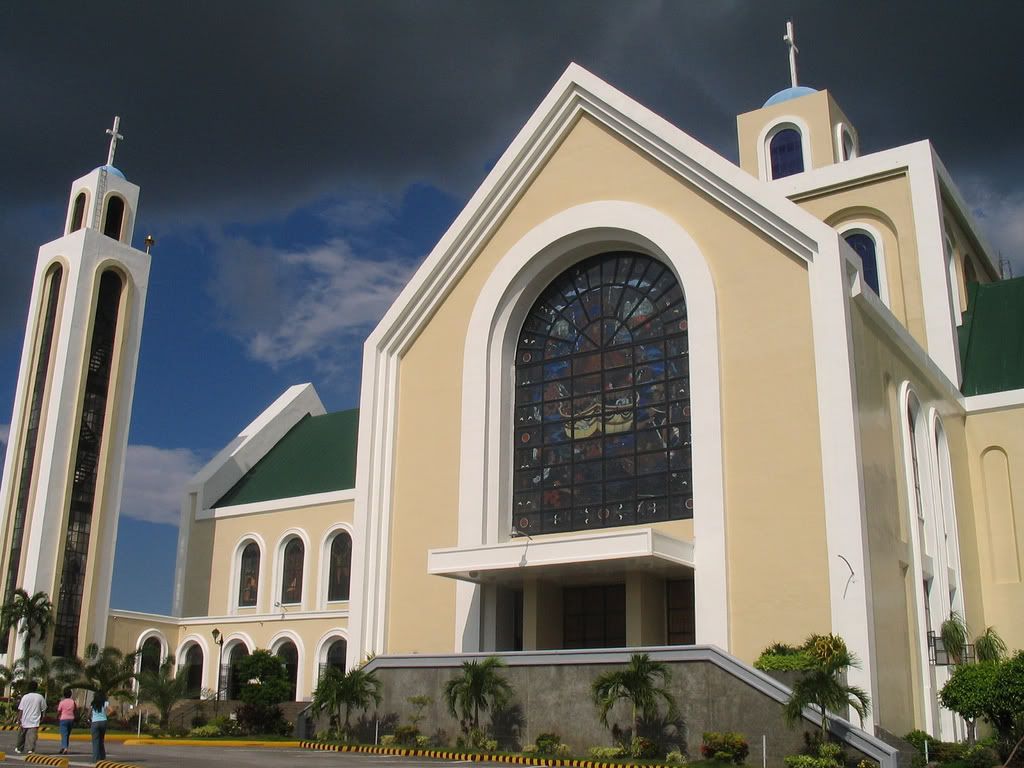
Our Lady of Peñafrancia Church was built in 1711 by Rev. Miguel Covarrubias. It houses the image of Our Lady of Peñafrancia. He constructed this church in fullfillment of the vow he made during his youth. The second church was built in 1750 by Bishop Isidoro de Arevalo, repaired and improved in 1876-1877 by Bishop Francisco Gainza. The image was solemnly crowned by the Rt. Rev. Guillermo Piano on September 20, 1924.
The concept for the building the Basilica Minore came from Archbishop Pedro P. Santos in 1960. Construction began on April 18, 1976, but was delayed for a number of years due to finance problems and was not completed until September, 1981.
On May 22, 1982 it was dedicated as The Church of Nuestra Señora de Peña de Francia and it wasn't until May 22, 1985 that the Church was given the title of "Basilica Minore" from Rome after a request from the third Archbishop of Caceres, Leonardo Z. Legaspi.
The Peñafrancia Basilica Minore houses an image of the virgin Mary that was sculpted in 1710. It was commissioned by Miguel de Cobarrubias who moved to the Philippines from Spain with his family and believed that the virgin Mary had helped him numerous times in his life.
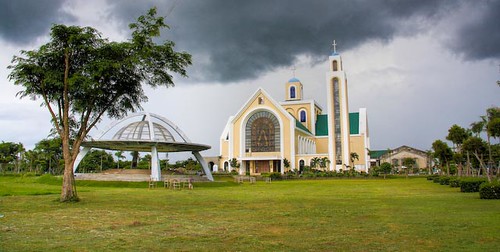
7) Kapitangan Chapel in Paombong, Bulacan. Kapitangan is known as a pilgrimage area during Holy Week. Devout Catholics flock to the barangay chapel to obtain the blessed oil believed to possess healing capabilities. On Good Friday, a reenactment of the Passion of the Christ is held.
8) Miagao Church in Iloilo. In 1993, Miagao church was included in UNESCO’s World Heritage List under the title "Baroque churches of the Philippines." The flanking towers, massive, and of unequal height gives Miagao the shape of a fortress. But it is the ornamentation of the church’s facade, designed like a retablo, which makes it unique.

The Church of Santo Tomas de Villanueva in the town of Miagao, Iloilo is one of the Philippines? architectural and religious gems. Built between 1787 and 1797, its fortress-like design suggests its dual purpose as a place of worship and as a fort used in defending the town against moro raiders at the time. It is one of only four (Augustinian-built) churches in the country to make it to the prestigious UNESCO World Heritage List.
Its unique features include the unusual Aztec like bas-relief in the fa?ade depicting St. Christopher carrying the baby Jesus through a tropical forest. The adobe used in building the church is made from silt and clay that can only be found in this part of Iloilo, giving the building a unique warm-yellowish glow. Flying buttresses from the side of the church walls are typical of the "earthquake baroque" design reminiscent of churches in Ilocos, particularly that of Paoay Church and Vigan Cathedral. Also of note are the dissimilar designs of the two belfries; both were commissioned by two different parish priests. The church?s simple interior is nevertheless highlighted by a striking gold-plated retablo.
Miagao is about 40kms south-west of Iloilo City. Jeepneys can take you from the city proper to this town in about 45 minutes.
Waypoint narrative by: Jay_J 2005
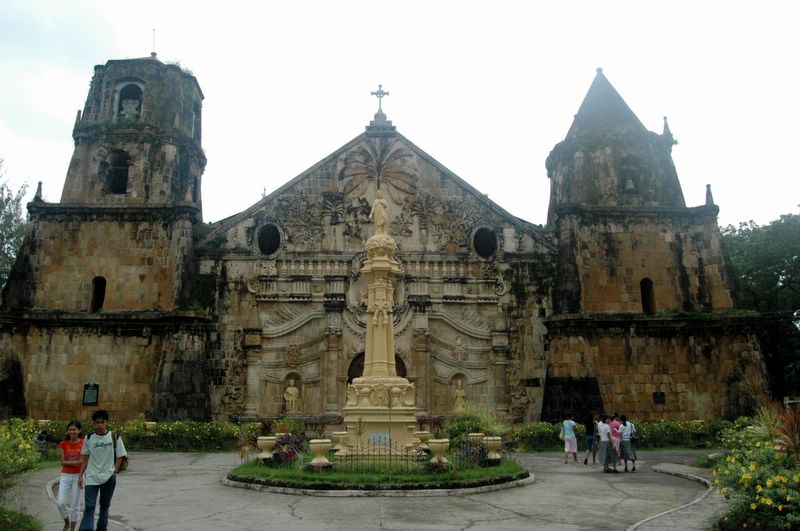
9) Our Lady of Manaoag in Pangasinan. The Church of Manaoag is one of the country’s major pilgrimage centers, owing its popularity to the miraculous image of Our Lady of Manaoag, an image of the Nuestra Señora del Rosario.

Our Lady of Manaoag (formally: Nuestra Señora del Santissimo Rosario de Manaoag, literal translation: Our Lady of the Most Holy Rosary of Manaoag) is a title given to the Blessed Virgin Mary, associated with a wooden statue, said to be from the 16th century. She is the patroness of the sick, the helpless and the needy. This holy image is very popular among Roman Catholics in the Northern Philippines, and has been much popularized among the inhabitants of the Pangasinan provincial Area. It is covered by the Archdiocese of the Lingayen-Dagupan district.
The province of Pangasinan is one of the Philippines' most widely visited Roman Catholic Pilgrimage sites. Many people from across the Philippine archipelago come and visit the town of Manaoag, where the statue of the Blessed Virgin Mary is enshrined in a church dedicated to this name.
The origins of the Our Lady of Manaoag started with the holy Augustinian fathers who were in charge of the spiritual administration of the Manaoag town from the year 1590 to 1613 in accords to the sanctified decree of Spain. It was accepted as a vicariate by the Dominican Provincial Chapter in 1614, under the patronage of Santa Monica.
According to documented recorded legend dating back to 1610, a native man who was walking home heard a Lady's mysterious voice. He looked around and with great awe saw the radiant Lady with a Rosary on her right hand and a Child on her left as she stood on a cloud veiling a treetop. The man fell on his knees. He told the people of the apparition. And soon right on the spot where the Lady appeared a church was built. A town quickly flourished around it and was called "Manaoag".
Tradition has it that the town itself was born from the Virgin’s call, thus the term, "taoag" meaning "to call" was used to name the town. This is where the name Manaoag was derived from, which means "She Calls".
10) Mount Banahaw in Quezon. Mount Banahaw is perhaps the country’s premier indigenously Filipino pilgrimage site. Mount Banahaw is a dormant volcano located on the boundary of Majayjay, Laguna and Lucban in Quezon. A pilgrimage to this so-called "holy mountain" is a most unique spiritual experience as it combines the culture of Catholicism with indigenous mysticism.
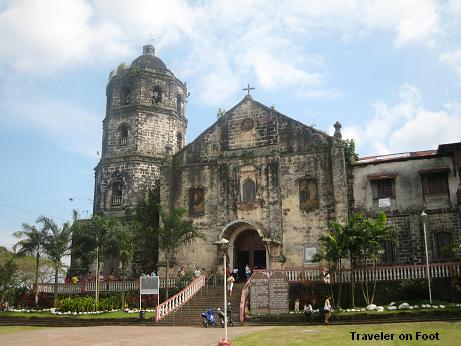

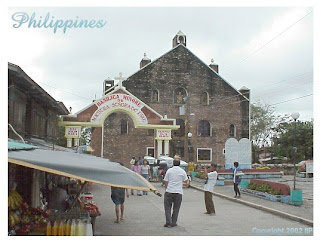

4 comments:
Great post for this Holy Week, miss ko tuloy ang lenten tradition na "Visita Iglesia" which my family regularly practice every Good Friday.
God bless you on this Holy Week.
Your post is very relevant to the Lenten season. And very much like a Tourism Department advertisement. Since it is one great and interesting blog post, I am passing to you THE NENO'S AWARD. Please check my latest post for details. Thanks and congratulations!
Happy Easter, too!
Wow Dens! Ang ganda ng churches! Great photos!
I also have you on the list for the Neno's award! That's what you get for being such a supportive blogger friend.
Actually left a message on Denzmeister
Here's the link:http://roncenteno.blogspot.com/2009/04/thank-you-david-funk.html
You have good points there, that's why I always visit your site, it seems that you are an expert in this field. keep up the fantastic work, My friend recommends your blog.
My blog:
meilleur taux www.rachatdecredit.net
Post a Comment